Nauticam announces housing for Canon 1DX Mark III
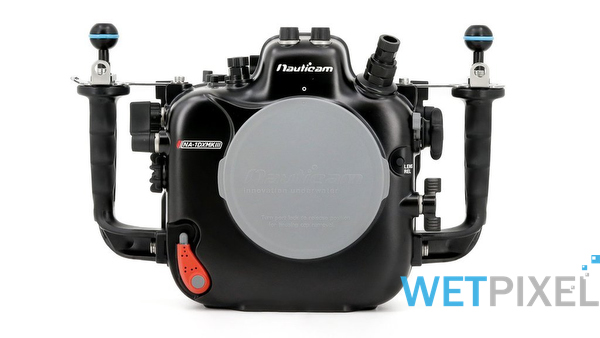
Nauticam has announced their housing for the Canon 1DX Mark III SLR camera. It offers HDMI 2.0 compatibility via an M28 bulkhead and uses the N120 port system. Strobe triggering is via optional manual or TTL flash triggers via fiber optic or with the supplied Nikonos 5 pin bulkheads and internal electrical board.
The NA-IDXIII is shipping now, priced at $5,635.
From Nauticam’s website
Nauticam NA-1DXIII Underwater Housing for Canon 1DX Mark III Camera
FOR CANON 1DX MARK III CAMERA
SKU # 17332
$5,635.00
The Canon EOS-1D X Mark II was the first DSLR to offer high quality 60p 4K recording in a pro-level body. Coupled to the camera’s amazing Dual Pixel autofocus and wide-ranging custom white balance capability, the 1D X Mark II was the benchmark for underwater DSLR video. With the EOS-1D X Mark III, Canon is introducing a new 20.1 MP CMOS Sensor with the widest ISO range of any EOS camera, 20FPS live-view Servo AF shooting, and 12-bit 5.5K RAW or DCI/UHD 4K at up to 60p recording. The EOS-1D X Mark III is a true all-in-one capture platform with incredible still and video performance.
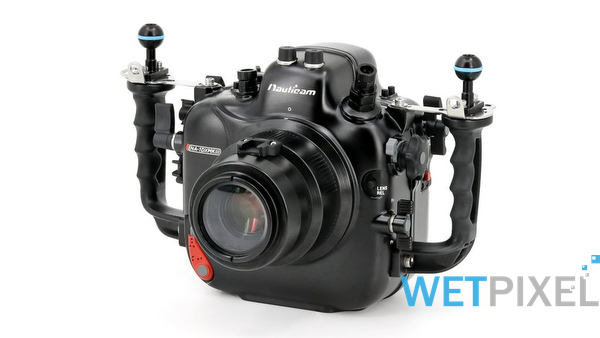
Technical Specifications
- Dimensions 360mm(W) x 235mm(H) x 145mm(D)
- Weight In Air 3.59kg
- Weight In Water -0.2kg (with camera and battery)
- Depth Rating 100m
- Port System N120
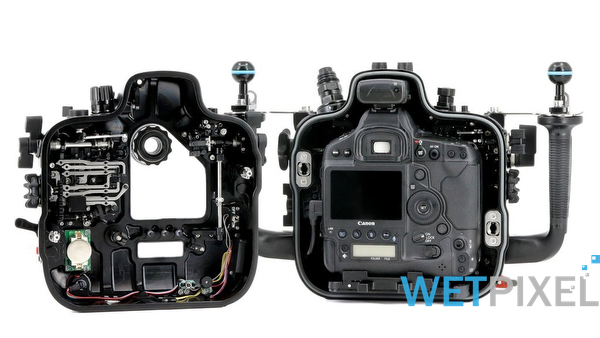
THE CANON EOS-1D X MARK III CAMERA
The Canon EOS-1D X Mark III is the brand’s flagship DSLR camera is constructed around a redesigned 20.1MP CMOS full-frame sensor. The new sensor is designed to give the camera both exceptional still and motion picture capabilities that satisfy the professional image and filmmaker’s criteria.
RESOLUTION, SPEED AND SENSITIVITY
The 20.1MP CMOS sensor has the highest ISO range of any Canon EOS camera at 100-102,400 with expandability options for a low of 50 and a high of 819,200 equivalent. In Live View, the Mark III will capture 20fps, even with a mechanical shutter, and has a continuous burst rate of 1,000 RAW or RAW+JPEG images thanks to the enhanced DIGIC X processor and the use of CFexpress 2.0 recording media.
AUTOFOCUS
Canon’s legendary Dual Pixel autofocus is the benchmark for underwater imaging. With the Mark III, Canon has increased the number of AF zones to 525 and adds Servo AF for moving subjects and claims their Movie Servo AF can now operate down to -6 EV during video recording.
VIDEO RECORDING
With 12-bit 5.5K RAW 60p internal recording, the EOS-1D X Mark III has positioned itself to not just maintain but also to grow the already large following it has in the underwater filmmaker community. While RAW may not be for everyone, the Mark III can also record DCI 4K at 60p from the full sensor width in 10-bit 4:2:2 using the H.265 HEVC codec. The ability to shoot using the full sensor was not possible with the Mark II and returns the full field-of-view so essential in wide-angle underwater video. There is still the option to shoot cropped DCI 4K as well (using about 75% of the camera’s sensor width) , giving some extra magnification when using macro lenses or even a little more zoom for wide-angle. Video can be captured with the cinema Canon Log OETF profile. This profile, developed for the C300 and C500 cinema cameras allows capture of the full 12 T-stop exposure latitude of the new sensor.
DURABILITY AND BATTERY
The EOS-1D X Mark III has a 500,000 shutter release rating with reduced black-out and mirror bounce characteristics in addition to extensive weather sealing in keeping with its position as the flagship DSLR. For those migrating or adding the Mark III to a workflow containing the Mark II will rejoice in the Mark III’s use of the same LP-E19 battery which delivers up to 2 hours of RAW or compressed 4K recording or a CIPA rated 2,850 still images using the viewfinder or 610 shots in Live View. This is a dramatic increase from Mark II which was rated at 1,210 and 260 shots respectively. This long record time gives the Mark III a distinct advantage over mirrorless systems that may record similar quality levels but offer shorter battery life.
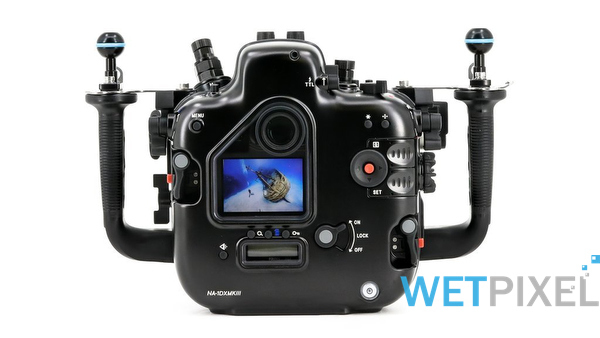
THE NAUTICAM NA-1DXIII UNDERWATER HOUSING
Nauticam has been providing innovative aluminum housings since the original EOS-1D X with each evolution adapting to the ever-changing role this camera plays in underwater image-making. The NA-1DXIII adds a host of video-centric enhancements as well as more refined ergonomics and control access for all shooting situations.
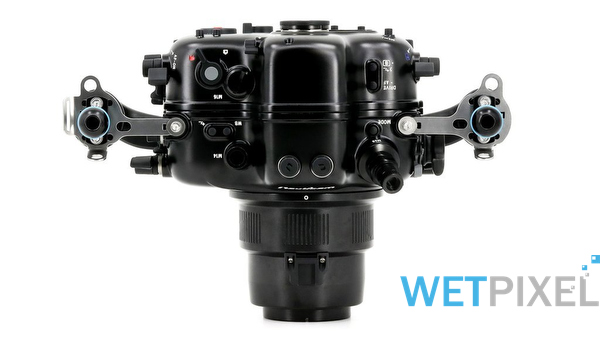
VIDEO RECORDING
While the EOS-1D X Mark III can capture incredible 5.5K 12-bit RAW internally, it can also output uncompressed DCI or UHD 4K video over HDMI at up to 30p. For those that prefer to use a more edit-friendly codec such as ProRes or DNX, the addition of an external monitor or recorder is an option. The NA-1DXIII features the large-bore M28 bulkhead that supports Nauticam’s HDMI 2.0 cable system and supported monitors/recorders such as the Atomos Ninja V. The system also supports the HDMI 1.4 standard for use with non-recording monitor solutions such as the SmallHD 502 Bright and comes with an M28 to M16 step-down adapter pre-installed. See the sidebar for recommended monitor housings and necessary connection accessories.
MISSION CONTROL
Regardless of where a button or control dial may lie on the camera body, Nauticam engineers obsess over making sure that access to that control on the housing be intuitively placed for ease of use to ensure no shot is missed while searching for a button or dial. The NA-1DXIII features a double-action thumb lever reachable from the right handle that actuates the AF-ON and RECORD buttons on the rear of the camera. A recessed dual-action lever that rests between the right handle and the housing triggers ISO and the M.Fn controls. A dual-action thumb lever on the left side is for PLAYBACK/INFO and another dual-action lever on the front left of the housing os for the customizable PV and FN controls. Large textured control dials on the right-side access the main and sub-command dials and a large dial on the left side is for controlling lenses equipped with manual focus or manual zoom gears.
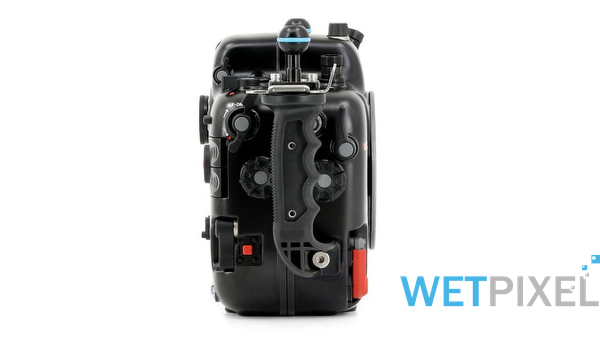
FLASH TRIGGERING
The NA-1DXIII supports flash triggering via the built-in fiber-optic bulkheads atop the housing through the use of Nauticam’s Manual or TTL flash triggers. The manual flash trigger provides high-speed optical triggering of supported strobes using LEDs powered by an internal user-replaceable battery. For TTL, the Nauticam Canon TTL Flash Trigger can be used. The NA-1DXIII also comes with two M14 5-pin Nikonos bulkheads pre-installed along with a Canon to dual Nikonos bulkhead hot-shoe cable for electronic strobe triggering. The M14 bulkhead is installed along with an M16 to M14 step-down adapter.
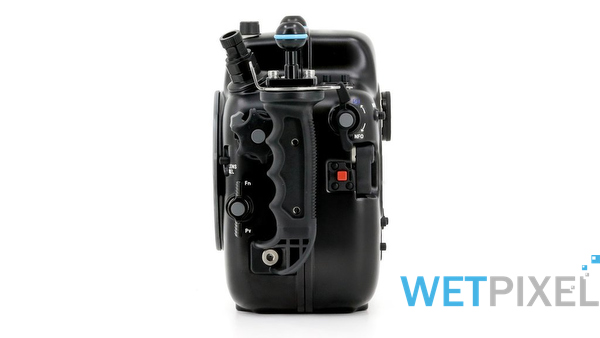
INTEGRATED VACUUM CHECK AND LEAK DETECTION SYSTEM
The Nauticam vacuum check and leak detection system is shipped with NA-1DXIII as standard equipment. Combined with an accessory vacuum valve (PN 25625 for M16 or 25624 for M14), this monitoring system provides constant updates on the watertight and safe-to-dive status of the housing. A simple color-coded LED lighting system lets the user know that the vacuum is solid, or that the housing is losing vacuum. Leak detection is built into the same circuit, so if there is water intrusion, an audible and visual indication will occur. The Nauticam system is temperature compensated, eliminating false alarms caused by a change in outside temperature, or from a camera heating up on an action-packed dive.
PREMIUM PROFESSIONAL OPTICS
Optical performance is just as necessary as camera performance and this becomes even more critical given the challenges of filming underwater. The Nauticam NA-1DXIII uses the same N120 Port System like the previous NA-1DXII which makes for a seamless transition for those upgrading to the Mark III. While this system provides exceptional optical-glass and flat port solutions for a wide variety of EF-mount lenses, the real power of the EOS-1D X Mark III can be realized using Nauticam’s Water Contact Optics. This lineup of dry and wet lenses are conceived using commercial lens-design software to achieve truly unparalleled underwater image quality both for stills and video in both macro and wide-angle situations. The WACP-1 and WACP-2 achieve ultra-wide 130º fields-of-view with reduced distortion over conventional optics while featuring ~0” minimum focus distances, zoom through capabilities and unbeatable corner sharpness at even wide-open apertures such as F5.6. The SMC-1 and SMC-2 macro wet-optics, when used with the Canon 100mm F2.8 macro lens provide 2x and 4x magnification respectively and the SMC-1 actually provides a resulting image with increased contrast and sharpness than the 100mm lens itself can achieve in the air without a magnifier.
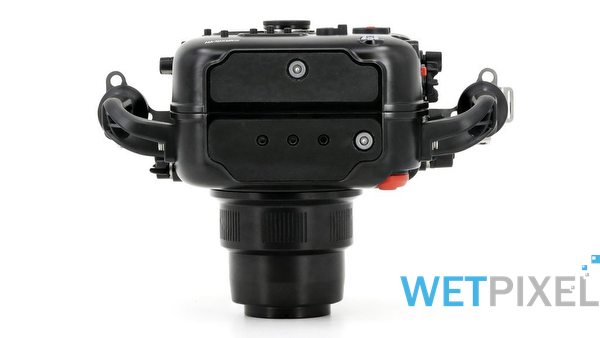
RESOURCES
What’s In The Box
- NA-1DXIII Housing
- 2x M14 5pin Nikonos bulkhead (NA008-01-Connector) - pre-installed
- 90048 Canon hotshoe plug to dual Nikonos connectors
- 25080 M28-M16 Step-Down Adaptor - pre-installed
- 25019 M16 to M14 step-down adaptor for electrical bulkhead - pre-installed
- 90134 Spare main O-ring, O-ring remover and lubricant
- 2x Optical bulkhead caps
- 2x Handles with mounting balls
- Panasonic CR-2450 Battery (for moisture alarm)
- Set of Allen Keys
- Manual instruction card
- Padded housing bag and shoulder strap
HDMI Recommended Configurations
For HDMI 2.0 Cable System
- 25089 M28 HDMI 2.0 Adapter
- 25091 M28C1R215-M28A1R170 HDMI 2.0 Cable (for NA-1DXIII to use with Ninja V housing) - Max.Output 4K30P 4:2:2 10 bit.
- 17922 Nauticam Atomos Ninja V Housing for Atomos Ninja V 5” 4Kp60 4:2:2 10-bit Reorder/Monitor/Player (excl. HDMI 2.0 cable)
For HDMI 1.4 Cable System
- 25033 Standard HDMI bulkhead with M16 thread*
- 25080 M28-M16 Step Down Adaptor (pre-installed on housing for Nikonos 5pin bulkhead)
- 25042 HDMI (D-C) cable in 240mm length (for connection from HDMI bulkhead to camera)